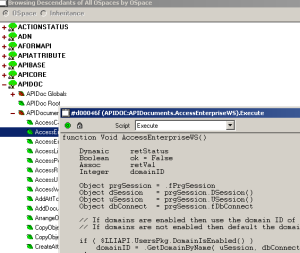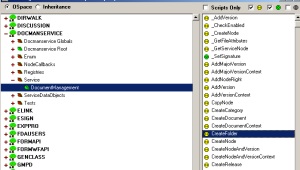Update:06/12/2017
Realized that OT is supporting old LAPI for their product called Enterprise Scan,Escan used to be completely a client app so if the Livelink server connecting to it is CS16 then OT ask you to install a module.Surreptitiously they call it “Private Bridge Interface” which is all the LAPI Oscript code conveniently bundled into its own Ospace.My guess is this will continue until ESCAN and AGA and other OT bread winners convert to SOAP or REST.
Update:12/29/2015 OT has announced that with the launch of CS 16 there will be no server side oscript to receive lapi calls so don’t waste your time reading this or programming in it.Just keeping this for vestigial reasons.
At time of this writing circa Feb 2013. Open Text’s livelink has been in the market for about 18 years and a fairly loyal fan share.The core software was always enhanced /added on by Oscript but for programmers who wished to do utilities such as adding user’s en masse, deleting things en masse et there was LAPI which stood for Livelink Application Programming Interface .In its inception what I used to see in around 2000,you could program in Java,which I did,there was VB6,there was then C & C++. Vended products such as Livelink Explorer,Authorlink, Autocad Integration etc was around there.In a nut shell these were the steps that one used to take.
- Install or copy lapi client files in your computer
- Write a program
- Compile it and run.
@RunTime the first call which everybody knew as Session creation was akin to Tel netting to the livelink server on Port 2099(default livelink server listening port). As time went by OT added a lot of calls at the LAPI server side so people built a lot of cool things.But there were problems in a way that as modern OOP languages came along they abhorred the idea that livelink was giving them Data structures(LLValue Objects) and making them work thru that.So OT did a small stint they loaded the LAPI libraries on top of a web server and called it Live Services but at that point one could write a web service call.I think it died like the OT’s foray into JavaObjects to replace or do side by side coding as in Oscript. I never understood what one would use JavaObjects for. Note I am not talking about the Oscript to Java Bridge which I have messed with and is very useful.
With the release of 9.7.1 they bundled livelink web services as part of the livelink install the idea bing a company would just use the existing IIS or Tomcat investment and start creating a plumbing conduit into livelink.At CS10 they stopped making a installer for LAPI. I am told that this is because they do not have the development resources to make libraries in several different languages.
The new web services are strongly typed,you never need to guess what you ask livelink and what you get in return.But while that is easy for a programmer to say and do the majority of programmers are called /hired to do something against livelink has no clue how livelink works.So that is where beautifully written /working hand holding programs are needed.Also a programmer need to understand what he is trying to do which may be as simple as logging into livelink and observing the different things.Jason Smith,Scott Grasley,Kyle Swidrowich these are all great OT programmers who are putting such structure into the new web services paradigm.Whenever I find time and needs some challenging stuff I also do put up some samples but most of my time nowadays are in oscript.
Coming back to LAPI the server side remains and will there be for what I can see. If OT basically puts their foot down and remove the API on the server then your program will not work. But then gain it probably is so far around you have no cause for concern.Not having an installer should be less worrying as any old API edition will work in java or a .NET language.That is what I do.I have a new 64 bit computer.I just copy the dll’s from a 32 bit machine and work on a .Net 2.0 framework.I also lost touch of java somewhere along the way.I guess I will have to brush up because OT is going to get us all programming in Eclipse 🙂
So in conclusion it really is your preference on how to code and how well to save your investment
A LAPI call received in the heart of livelink in oscript.If the AccessEnterprise call one sample was not there your investment would suffer
Going by the same token a web services call received in livelink
As you can see when you program in a client application your call needs to come into livelink.In web services they use the web server to get into livelink code.
At this point you are able to create a lapi code page and call the web services code or a web services code piece and call lapi .Increasingly over time lapi server side will cease to be and no effort will go into its up keep.In older versions of web services they used the LAPI dispatcher to send in the web services command now I don’t think it has a dependency on that.
Chris Morley’s comment a little more computer trained person than me
https://knowledge.opentext.com/knowledge/cs.dll?func=ll&objId=33077212&objAction=viewincontainer
Almost Diatribe from an angry user it is fun


kool info..thnx for sharing 🙂
BTW There is also a risk if you remain in LAPI.With CS10 there are tons of new features like Facets etc.Since LAPI is in deprecated status there is no way new things will happen so in all practical purposes it will die so sooner the better if you can get a handle of WS.
Hi..this is Indranil..can you please let me know if a content’s physical path is retrievable using LAPI code. If so, can you please share a piece of code for the same
The bundled client code from Open text that you may be referring to LAPI ,official OT stuff can be used to execute a LiveReport object.
If your organization stores files in a EFS(External File Store) you can then get it .However if your intention is to get a file as a user wants to get it like in a download action then lapi just needs an objectid/dataid handle and a FetchVersion call.Plenty of examples are available in the KB/web.There is nothing preventing an organization not to store documents in a medium other than EFS.Then what you will get is basically the provider info,if it is archive server it may look like D2@12345f###rrrr%%%%ggggjjjj7777.In my e.g it is saying I have content in a archive server on d2 and that is the docid of it.In EFS you may get something like \000\\234\\456\\12345.dat.No serious livelink organization will give a lapi coder access to its file store or archive server without sufficient reason as that content is supposed sacred to livelink and not to be opened up to lapi developers